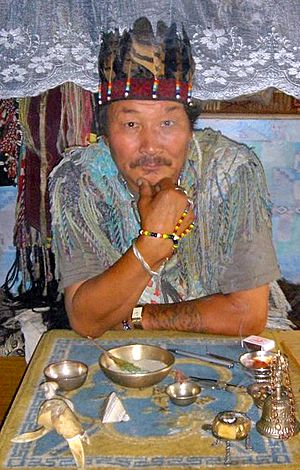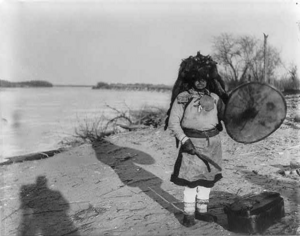Shamanism facts for kids
Shamanism is a practice where a practitioner reaches altered states of consciousness. Supposedly, the shaman perceives and interacts with a spirit world, and channels these energies into this world.
A shaman is a person regarded as having access to, and influence in, the world of good and bad spirits. They usually enter into a trance state during a ritual, and do divination and healing. To become a shaman, a person has to have had a near death experience (a "shamanic illness").
The name "shaman" comes from the Evenki people in Siberia.
Shamans play a central role in these movements, as they can be in both worlds, this one, and the world of spirits.
Beliefs
- Spirits are real and can do things in the real world.
- There are good and evil spirits.
- Healing can be done in the spirit and real world.
- A person's spirit can leave their body and go into the world of the spirits.
- Animal shapes are used to interact with the spirits.
Shamanism is different from animism.
Images for kids
-
The earliest known depiction of a Siberian shaman, by the Dutch Nicolaes Witsen, 17th century. Witsen called him a "priest of the Devil" and drew clawed feet for the supposed demonic qualities.
-
A shaman, probably Khakas, Russian Empire, 1908
-
South Moluccan shaman in an exorcism ritual involving children, Buru, Indonesia (1920)
-
A shaman of the Itneg people in the Philippines renewing an offering to the spirit (anito) of a warrior's shield (kalasag) (1922)
-
Sámi noaidi with his drum
See also
 In Spanish: Chamanismo para niños
In Spanish: Chamanismo para niños










